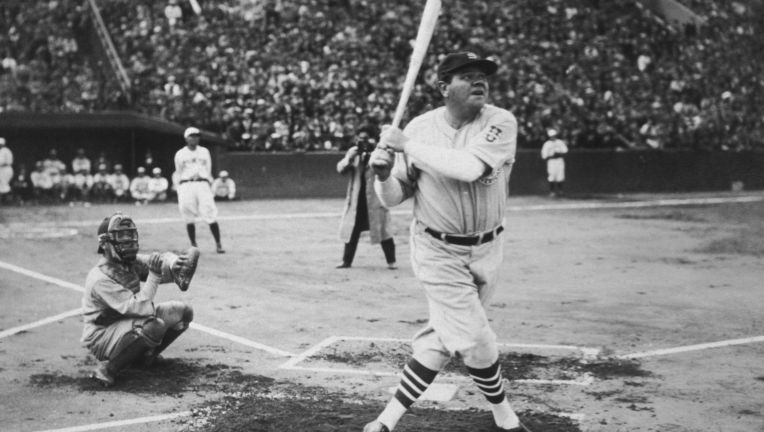Baseball History Comes Alive Now Ranked #2 by Feedspot Among All Internet Baseball History Websites and Blogs!
Guest Submissions from Our Readers Always Welcome!
Subscribe to Baseball History Comes Alive! for automatic updates (sign-up block found in right side-bar)
As a Free Bonus for subscribing, you’ll get instant access to my two Special Reports: Memorable World Series Moments and Gary’s Handy Dandy World Series Reference Guide!
“The1934 Tour to Japan” Photo Gallery
Click on any image below to see photos in full size and to start Photo Gallery:
- The Babe sides safel into second on the 1934 tour.
- The entire American All-Stars team (complete player ID’s available upon request)
- The Babe having some fun with Japanese youngsters.
- The Babe during the welcoming parade attended by over 500,000 Japanese
- Newspaper account of the 1934 tour
- American players walk on to the field in Toyko
- The Babe lounging aboard the Empress of Japan ocean liner
- The Babe with wife Claire and daughter Julia aboard the ocean liner, the Empress of Japan
- Part of the American entourage with their wives: Eric McNair, Doc Ebling, Babe Ruth, Bud Hellerich, Lefty Gomez.
- The Babe greeted by some Japanese ladies
- Portrait shots of the entire American team (ID’s available upon request)
- Jacket worn by Moe Berg on the tour
- Some of the players in Japan
- Complete group photo
- American players enter the field
- Babe Ruth receiving flowers from a young girl during the 1934 tour to Japan.
- The Babe and family aboard the ocean liner
- The ocean liner the Empress of Japan arriving in Yokohama harbor on November 2, 1934.
- Babe Ruth autographed ball from the tour
- Commemorative Japanese stamp of the 1934 tour
- Group photo in Japan
- The Babe autographs a ball in Japan
- Scene from the 1934 tour, Lou Gehrig visible
- Babe with wife and daughter as they start on their round the world trip
The 1930s Baseball Barnstorming Tours to Japan, Part II: The 1934 Tour
“The 1934 tour would have never happened without Babe Ruth, because – even though he was at the end of his playing career – he was still the most popular and famous athlete of his day.” Tom Shieber, National Baseball Hall of Fame and Museum
The 12-city extravaganza featured a formidable entourage of baseball talent. Included were some of the biggest stars of the game: Earl Averill, Lou Gehrig, Charlie Gehringer, Lefty Gomez, Connie Mack, Jimmie Foxx, and of course, the star attraction, Babe Ruth. Less recognizable names on the tour included Earl Whitehill, Eric McNair, Frankie Hayes, Bing Miller, Joe Cascarella, Lefty O’Doul, “Rabbit” Warstler, spy Moe Berg, A’s trainer “Doc” Ebling, and umpire John Quinn. Also among the group was Bud Hellerich, who had founded the Louisville Sluggers Company more than 50 years prior.
And what a reception the American “ambassadors of goodwill” received! It was reported that over 500,000 Japanese lined the streets of Tokyo for the welcoming parade, all hoping to catch a glimpse of the great Bambino. Try to picture the scene with the always-animated Babe cheerfully  acknowledging the warm reception by waving Japanese and American flags, while flashing the huge Babe Ruth grin as he rode through the massive sea of adoring fans.
acknowledging the warm reception by waving Japanese and American flags, while flashing the huge Babe Ruth grin as he rode through the massive sea of adoring fans.
Shop MLB.com. The Official Online Shop of Major League Baseball.
Gary Livacari
Photo Credits: All from Google search
Information: Excerpts edited from an article on National Baseball Hall of Fame website; and from the 1934 Tour to Japan Wikipedia page
Check out my latest book, recently nominated for the SABR 2020 Lawrence Ritter award: Reflections On the 1919 Black Sox: Time to Take Another Look now available on Amazon in e-book and paperback. All profits go to the Illinois Veterans Foundation
We are a participant in the Amazon Services LLC Associates Program, an affiliate advertising program designed to provide a means for us to earn fees by linking to Amazon.com and affiliated sites. Click here to view Amazon’s privacy policy


























Gary enjoyed part two. When time permits would you post the player Id’s for the two photographs.
You keep the stories fresh and interesting. Ken DiVincenzo .
Group Shot in Japan:
Top Row, L-R: Doc Ebling, Earl Whitehill, probably Clint Brown, Eric McNair, Frankie Hayes, Connie Mack, Babe Ruth, Bing Miller, Joe Cascarella, Lefty O’Doul, Lou Gehrig. Front Row, L-R: Earl Averill, Rabbit Warstler, Charlie Gehringer, Lefty Gomez, Jimmie Foxx, Moe Berg.
Portraits:
Top Row, L-R: Bing Miller, Joe Cascarella, Moe Berg, Earl Whitehill, Lefty Gomez, Frankie Hayes, Clint Brown. Middle Row, L-R: John Quinn, Robert Schroeder, Babe Ruth, Connie Mack, unknown*, Doc Ebling. Front Row, L-R: Sotaro Suzuki, Lou Gehrig, Charlie Gehringer, Eric McNair, Jimmie Foxx, Rabbit Warstler, Earl Averill
*this might be an injured player who did not go on the trip, but so far I can’t place him. I know Charlie Berry was injured and did not go on the trip to Japan, but this guy doesn’t look like him.
Robert Schroeder worked in the A’s front office.